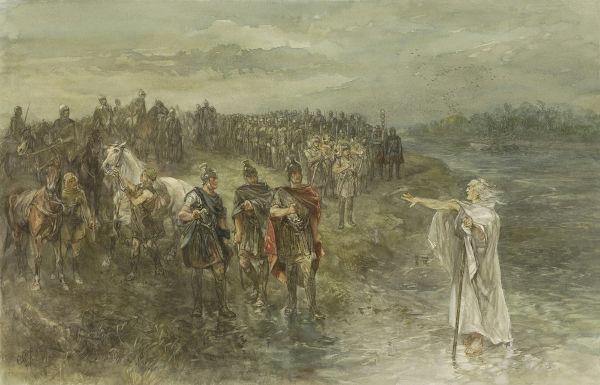THE Battle of Berlin was practically the last chapter of Second World War in Europe and sealed the fate of the Nazi Reich. The German defeat brought great destruction to the German capital, as there was a feeling of revenge in the Red Army after the devastation caused by the Nazis in the Soviet Union. The siege of Berlin led Adolf Hitler to commit suicide in April 1945.
Background
The war had been started in Europe by German aggression. Since he had risen to power, Adolf Hitler pursued armed conflict and prepared Germany for it. In September 1939, he started the war with the invasion of poland. After initial years marked by victory, Hitler's ambition led him to pursue his main objective: the conquest of the Soviet Union.
However, the invasion of the Soviet Union, begun in June 1941, marked the beginning of the end of the Reich. After almost conquering Moscow, the German advance on the Soviet Union lost steam and, through unimaginable efforts, the Soviets managed, little by little, the return of the Nazis to Germany. This ended up costing millions of Soviet lives, making the country the deadliest country in the entire Second World War.
The collapse of Nazi Germany became certain with the defeat in Battle of Kursk. After this battle, the country found itself surrounded by the Allies: the Soviets were advancing rapidly through the east, the Americans and British advanced in the south, from Italy, and in the west, from the France. Germany, which had led to the destruction of most of Europe, paid dearly for this in 1945.
Hitler's uncompromising stance on not backing down created numerous pockets of Nazi resistance in different parts of Europe. This was seen by historians as a serious strategic error, because if these troops had retreated, could have strengthened the resistance in Germany, which would have made the war last a few more months.
One such pocket of Nazi defense was the Hungarian capital, Budapest, where Hitler did not authorize the withdrawal of German troops and ordered resistance to the last man. The city surrounded by the Soviets was destroyed and, of the approximately 50,000 German soldiers, only 700 managed to escape, with the rest being killed or taken prisoner. The last step in consolidating the Allied victory was to conquer the city of Berlin.
destruction in berlin
The conquest of Berlin, according to historians, was Stalin's obsession, as it was seen as the ideal revenge to repay all the destruction wrought by the Germans in the Soviet Union. In addition, mastery of the city was essential to the Soviet plans, which consisted of obtaining classified information from the Germans about the construction of atomic weapons.
The war in 1945 took disastrous proportions for Germany as it brought the country into total collapse. According to historian Max Hastings, only in 1945, Germany had had more deaths than during the entire period of 1942 and 1943:
Do not stop now... There's more after the advertising ;)
In January alone, 450,000 Germans died; in each of the next three months, there were more than 280,000, including victims of the Anglo-American bombing of Dresden, Leipzig and other eastern cities. During the last months of 1945, more Germans died than during 1942 and 1943. These numbers underscore the price paid by the people for the failure of their army leaders to depose the Nazis and end the war before their terrible final act.|1|.
The Soviet encirclement of Berlin mobilized 2.5 million soldiers, Besides 6,250 armored and 7,500 planes|2|. The initial attack was against the Seelow hills, where the German defenses were severely punished by Soviet artillery. The scale of the Soviet attack can be measured by the statistic offered by historian Antony Beevor: on April 16 alone, more than 1.2 million bombs were dropped on Berlin|3|. The attack on Seelow was launched that day and, by April 21, the region had already been conquered with a balance of 30,000 Soviets killed against 12,000 Germans|4|.
After the conquest of the Seelow Hills, the conquest of the city began, where fighting was fought from street to street. The Nazi resistance had been hastily called up by the Nazis and the men were urged to fight to the death. At this point in the battle, this resistance was down to about 100,000 men, who fanatically fought in defense of Berlin.
During the attack on Berlin, Soviet soldiers were spurred on to exact revenge and launched a frenzy of murder and rape against civilians that shocked the Allies. Stalin considered this a deserved spoils of war for the soldiers, after years of war and all the suffering caused by the Germans. Soviet violence led thousands of Berliners to commit suicide so as not to be victims either.
On April 30, the Soviets invaded and conquered the Reichstag (parliament) and, a few hours later, hitler committed suicide along with his wife, Eva Braun. After his death, the command was handed over to the admiral Karl Donitz, and the official surrender of Nazi Germany took place on May 2, 1945. Despite the existence of some localized pockets of Nazi resistance, the war was practically over in Europe.
A few days after the defeat at the Battle of Berlin, Germany surrendered to the Allies. On May 7, Wehrmacht Chief of Staff Alfred Jodl signed a surrender document, and on the following day, May 8, a second and final surrender document was signed. On that day, the President of Germany, Karl Dönitz, communicated to Germany that the country had officially surrendered to the Allies.
|1| HASTINGS, Max. The world at war 1939-1945. Rio de Janeiro: Intrinsic, 2012, p. 636.
|2| Idem, p. 643.
|3| BEEVOR, Antony. The Second World War. Rio de Janeiro: Record, 2015, p. 817.
|4| HASTINGS, Max. The world at war 1939-1945. Rio de Janeiro: Intrinsic, 2012, p. 645.
By Daniel Neves
Graduated in History

